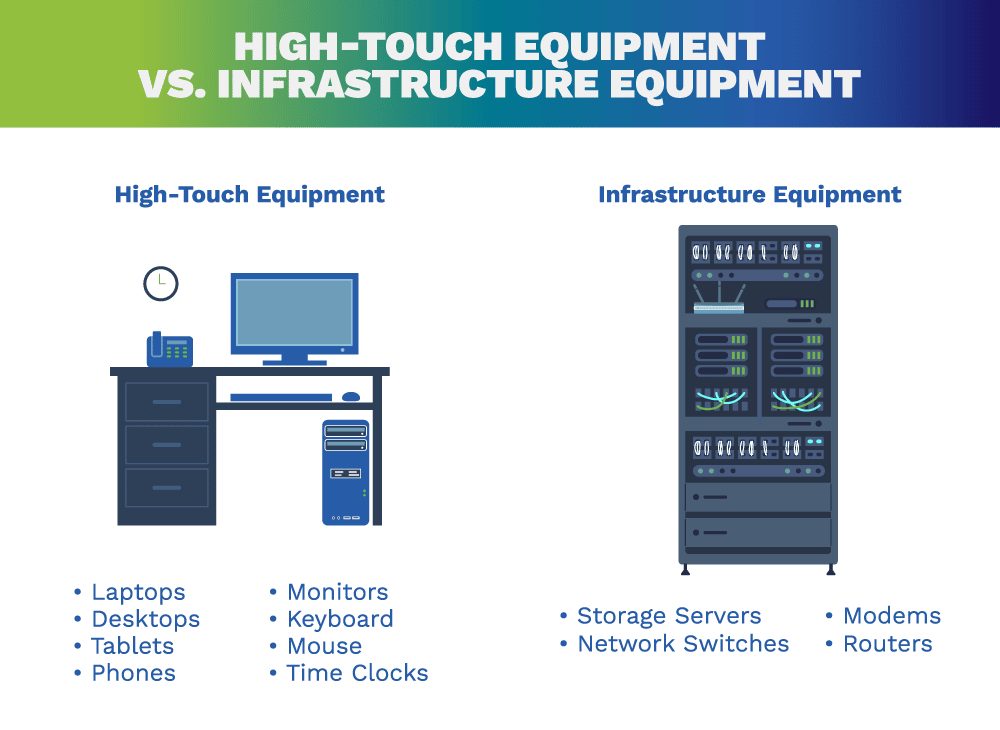Like all things, computers and other electronics become obsolete over time. However, determining the right time to replace your equipment is often easier said than done. Read on to learn when it’s time to replace your network equipment.
Along the way, we’ll cover the average usable lifespan of information technology (IT) hardware, reasons to refresh and recycle your equipment, and options for your retired, outdated, or damaged assets.
What Is the Average Usable Lifespan of IT Hardware?
The average usable lifespan of data-bearing equipment varies.


“High-touch” equipment — like laptops, desktops, tablets, phones, monitors, time clocks, and workstations — is regularly touched and used. As you might expect, these devices will be subject to more wear and tear and will need to be replaced or upgraded regularly. . You may also have more individual units to replace across your organization.
Meanwhile, “infrastructure” equipment — like storage servers, network switches, modems, and routers — is “always on” in the background but rarely accessed physically, so the hardware itself takes less direct damage. Usually these devices get replaced due to age or storage limitations rather than physical failures. There are also fewer individual units to replace. On the flip side, infrastructure equipment presents additional data concerns, since these devices typically hold or transmit the most sensitive information within an organization. As more businesses rely on cloud computing and remote work solutions, the need for secure infrastructure, up to and including disposal, is only growing.
4 Reasons to Refresh and Recycle Your Equipment
It’s important to replace your equipment when necessary, to protect your organization from costly liabilities. Here are four major reasons why you should refresh and recycle your equipment.
1. The Equipment Is No Longer Supported by the Original Equipment Manufacturer (OEM)
When the OEM no longer supports your hardware and software, it may be hard to repair or find parts for them. To illustrate, let’s say your workstations are 2010 desktops that the manufacturer no longer supports. As a result, it’s difficult to repair them. You’re also more likely to get hacked — research by Northwestern University has shown that old hardware and software are more likely to have vulnerabilities that threat actors can exploit.
2. Equipment Failure or Irreparable Damage
You should refresh and recycle your IT assets if they have failed or undergone irreparable damage. Sometimes equipment fails ahead of its expected lifespan for reasons that can’t be easily patched, or new and old equipment refuse to communicate with each other. In cases of a disaster like a flood or fire, it is unlikely that damaged equipment can be recovered and restored to usefulness.
3. Your Equipment or Network Has Been Affected by Data Security Events
If your equipment has been hacked or compromised, it is a good idea to consider replacing affected devices If you don’t wipe the hard drive and retire the device, the infection may spread to other devices. For the same reason, you should consider recycling and replacing devices if an IT security audit reveals they’re vulnerable. Insecure connections are much more likely targets for cybercriminals due to inadequate security.
4. New and Better Equipment Becomes Available
Finally, you should replace and recycle your equipment when new and better versions come out in the market. Newer equipment is usually more secure, efficient, and user-friendly. You should also replace your modems if they no longer support first-class security standards and encryption, such as WPA3.
You may not always have a choice but to upgrade or lose support for your current equipment. OEMs sometimes “force” you to upgrade by replacing a legacy product. Sonos, for instance, stopped updating some of its oldest products with new features and software updates, essentially forcing its customers to buy new speakers if they wanted to continue using their sound system.
Options for Your Retired, Damaged, or Outdated Equipment
Now that you know when to replace your equipment, here are some good ways to dispose of your outdated, retired, or damaged equipment.
Recycle with a Certified IT Asset Disposition (ITAD) Provider
First, you can recycle with a certified IT asset disposition (ITAD) provider. These companies specialize in:
- Recycling and repurposing old equipment
- Data destruction and reporting
- Audits and chain of custody security
- Protection from liability and regulatory compliance
- Producing certificates of destruction, which guarantee the destruction of all data on your equipment
ITAD digital data destruction providers give you peace of mind because they follow established cybersecurity standards and laws for data disposal, such as the U.S. Department of Commerce’s National Institute of Standards and Technology (NIST), the General Data Protection Regulation (GDPR), and the California Consumer Privacy Act (CCPA).
Sell Your Equipment as E-Scrap in Bulk
Alternatively, you can get rid of your old devices by selling them as bulk e-scrap or e-waste. E-scrap refers to electronic equipment that is no longer necessary or functional, but can be recycled for raw materials like plastic, glass, and metals.
Some electronics recyclers will buy e-scrap by the truckload without a process for itemizing or tracking individual units. This can be a fast way to clear out an inventory of unwanted equipment, but it does leave you open to liabilities if those devices aren’t handled properly once they leave your custody. If a data breach or theft can be traced back to your organization even after the equipment is decommissioned, you could be on the hook for damages.
Each state and country has different options for selling e-scrap. Some of these options include:
- Special collection events like those created for Earth Day (generally these are “drop-off” events and you will not be paid for your material)
- Local collection sites like recycling centers and waste depots (some fees may apply)
- Stores or manufacturers involved with “return to retail” recycling
- Online E-scrap brokering sites
E-scrap sites are like Amazon, but for e-waste. Businesses can register accounts and list the materials they want to sell. Participating recyclers can then buy listed materials by contacting businesses through the site.
Unfortunately, selling your equipment as e-scrap has many risks:
- E-waste marketplaces typically don’t provide documentation
- E-waste events, sites, and manufacturers tend to value equipment at the same cost, so you may not get the prices you deserve
- There’s no chain of custody or guaranteed data destruction, so your or your clients’ personal data could get leaked and misused, potentially putting you at risk of severe fines according to relevant privacy laws and standards
Resell Through Private Markets
If you’re uncomfortable with selling your equipment to brokers, you can resell your assets through private markets, such as eBay. This can be effective if you only have a few highly specific, gently-used units or parts to sell, and you know they are high-value. However, you again risk your data being sent to the wrong hands. Even if you use a do-it-yourself data destruction tool, . There is also the time and labor involved with creating and maintaining online listings, advertising, and shipping individual units.
Donate Usable Equipment
Lastly, you can donate usable equipment to charities, schools, and libraries. We strongly recommend consulting an ITAD company to ensure data security compliance before donating.
Start Recycling Your It Hardware and Digital Devices Today

Getting rid of your IT equipment can be trying, especially if you’ve never done it before. That’s where Cobalt comes in.
Cobalt knows how to separate your valuable and sensitive equipment from your scrap and documents every step of the process, from triage to data sanitization to reporting and certificates of destruction. We also boast a hard drive sanitizing system and a mobile hard drive shredder that we can bring to your site to destroy data right before your eyes. Our processes are backed by third-party environmental and data security certifications, which we are audited for regularly. Contact us today to learn more about our ITAD services and how we can help you.





